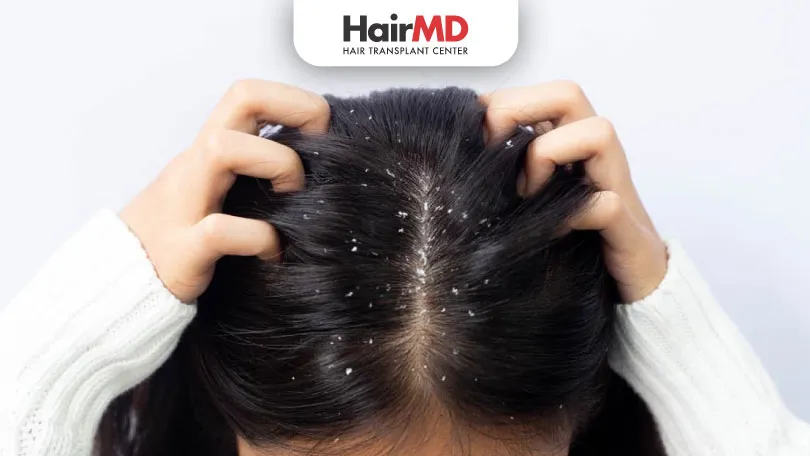14th August, 2025
Minoxidil is a widely prescribed medication to treat hair fall or hair thinning (like most topical applications). Minoxidil does a lot of things: it works as an anti-hypertensive agent, promotes vasodilation of blood vessels, stimulates new hair follicles in the bald or thinning scalp, along with other benefits.

But with all these benefits, there is also an associated side effect that is easily noticeable – dandruff over the scalp area. When people use it for a while, they might experience dry scalp flakes over the scalp. Since Minoxidil is working on increasing the blood flow (to the scalp) of the user, it can also lead to dryness in the affected areas as well.
These dry flakes are often referred to as minoxidil flakes. At HairMD, patients often ask us, ‘How to get rid of Minoxidil flakes?’ or ‘How to get rid of dry scalp?’ Well, I will try to answer all the queries along with the benefits and side effects of Minoxidil.
Table Of Content
-
How to Get Rid of Dry Scalp Flakes Due to Minoxidil?
- Minoxidil Flakiness: How to deal with it?
- How to Get Rid of a Flaky Scalp?
- FAQ
- Conclusion
How to Get Rid of Dry Scalp Flakes Due to Minoxidil?
Dry, flaky scalp after starting Minoxidil is common and frustrating—but it’s also manageable with the right care. In this guide, you’ll learn why it happens, quick fixes you can try today, and expert-backed tips to keep your scalp calm while staying on track with hair growth goals. Answered by hair specialists in Pune.
Minoxidil Flakiness: How to deal with it?
Flakes or minoxidil dandruff can either be dried minoxidil or dried skin from the scalp. After figuring out what it is exactly, you can go with the treatment part. This condition is temporary. If you are using minoxidil regularly then you should know that it contains alcohol. So when you apply it every day on the scalp, the alcohol in it vaporizes and the remaining contents of minoxidil remain on the scalp which causes flakes.
How to Get Rid of a Flaky Scalp?
- Switch to a foam-based Minoxidil – foam is usually alcohol-free and gentler for sensitive scalps.
- Reduce application frequency – only after doctor’s advice to avoid losing progress.
- Use a mild, moisturising shampoo – avoid harsh sulphates that strip natural oils.
- Moisturise your scalp – use dermatologist-recommended oils or barrier-repair serums.
- Check for allergies or dermatitis – consult a hair specialist to rule out contact dermatitis or dandruff.
FAQ
Conclusion
Popular Q&As
How to use dermaroller and minoxidil for hair loss?
How to use a dermaroller and minoxidil for hair loss? Dr Dhananjay Chavan dermatologist has given all information, follow the steps to get more idea about it.
Does PRP work for hair loss in men?
Let us try to know Does PRP for hair loss in men really work. I Dr. Dhananjay Chavan renowned dermatologist will try to give all the information about PRP.
Should You Use Minoxidil for Hair Loss?
Minoxidil is a leading treatment for hair loss. Find out if it’s the right option for your hair thinning and how it promotes regrowth.
We Got Your Back! Ask Us Anything On Your Mind!
Reach out to us on


